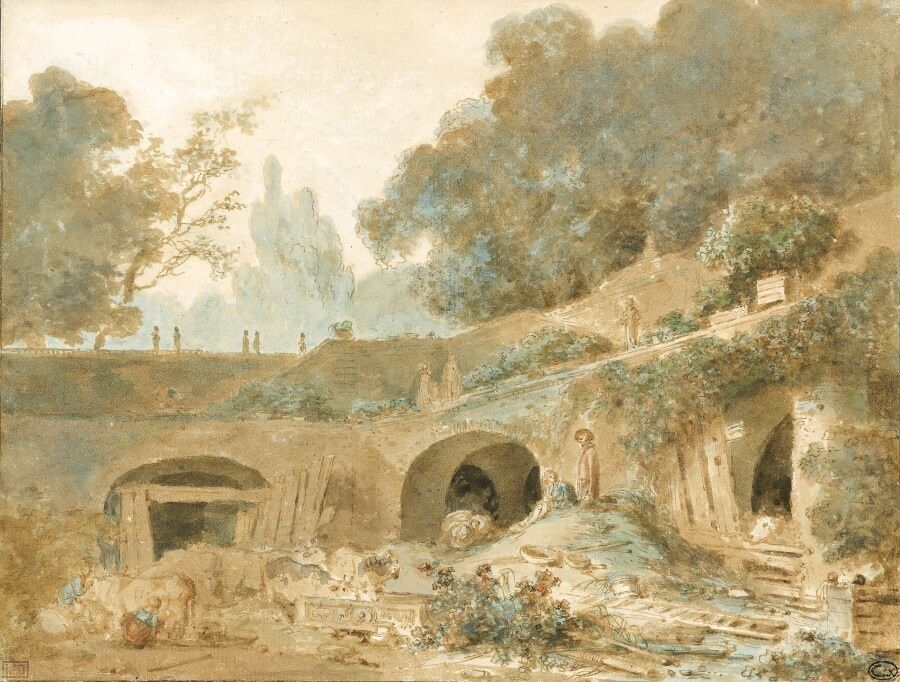Description
Jean-Honoré FRAGONARD (Grasse 1732-1806 Paris) The Terrace Watercolor gouache, pen and brown ink, traces of black pencil Height 19,5 cm ; Width : 25,5 cm Provenance: - Sale P G, April 2, 1861, n° 285 - Former Deglatigny collection, 3rd sale, Paris, Hôtel Drouot, June 14, 1937, n° 92, stamped lower left (Lugt 1768a) - Former Cailleux collection, stamped lower right Bibliography: A. Ananoff, L'oeuvre dessiné de Jean-Honoré Fragonard (1732-1806): catalog raisonné, Tome II, Paris, 1963, n° 837, reproduced B. Scott, Letter from Paris, Fragonard at the Grand Palais, November 1987, p.443, repr. fig. 3 Exhibitions : OEuvres de Fragonard, Grasse, musée Fragonard, 1957, n° 52 Three Masters of the Landscape, Fragonard, Boucher and Robert, Richmond, Virginia Museum of Art, 1981, n° 9 Aspects de Fragonard, Paris, galerie Cailleux, 1987, n° 49, reproduced This lively watercolor is to be placed at the beginning of Fragonard's stay in Rome, around 1758-60. The artist conceived an amusing scene, both rural and classical. In the foreground, oxen jostle for water in a Roman marble sarcophagus transformed into a feeding trough; the site, with its brick openings under the terraces, resembles an ancient ruin reused by the peasants and gardeners of the park. Flowers or brambles grow here and there, a mound serves as a resting place, a young Roman woman milks a cow, the ruins shelter a stable, a ladder is carelessly placed on the ground on the right. Above, the classical and domesticated order of a park is set up, with its orange tree in a box and the sculptures scandalizing the terraces. The foliage scatters and climbs to the trees, in a lively swarming. Fragonard's quivering hand melts the classical and ancient ages into a poetic vision where man and nature adapt to each other in the various strata of their mutual development. This watercolor can be compared to a small group of washes dating from 1758/60, such as "Parc d'une villa italienne" now in the collection of Jean Bonna, or "Scène dans un parc" in the Cleveland Museum (see Suite française, dessins de la collection Jean Bonna, Paris, ENSBA, 2006, Musée d'Art et d'Histoire de Genève 2007, ed. ENSBA, no. 47, repr. and ill. 1, p. 204). This spirit persists in Fragonard, as in the "View of an Italian Park" in wash executed around 1775/80 (presented at Didier Aaron in 2000, Paris-London-New York, no. 16, reproduced). Expert : Cabinet DE BAYSER
8
Jean-Honoré FRAGONARD (Grasse 1732-1806 Paris) The Terrace Watercolor gouache, pen and brown ink, traces of black pencil Height 19,5 cm ; Width : 25,5 cm Provenance: - Sale P G, April 2, 1861, n° 285 - Former Deglatigny collection, 3rd sale, Paris, Hôtel Drouot, June 14, 1937, n° 92, stamped lower left (Lugt 1768a) - Former Cailleux collection, stamped lower right Bibliography: A. Ananoff, L'oeuvre dessiné de Jean-Honoré Fragonard (1732-1806): catalog raisonné, Tome II, Paris, 1963, n° 837, reproduced B. Scott, Letter from Paris, Fragonard at the Grand Palais, November 1987, p.443, repr. fig. 3 Exhibitions : OEuvres de Fragonard, Grasse, musée Fragonard, 1957, n° 52 Three Masters of the Landscape, Fragonard, Boucher and Robert, Richmond, Virginia Museum of Art, 1981, n° 9 Aspects de Fragonard, Paris, galerie Cailleux, 1987, n° 49, reproduced This lively watercolor is to be placed at the beginning of Fragonard's stay in Rome, around 1758-60. The artist conceived an amusing scene, both rural and classical. In the foreground, oxen jostle for water in a Roman marble sarcophagus transformed into a feeding trough; the site, with its brick openings under the terraces, resembles an ancient ruin reused by the peasants and gardeners of the park. Flowers or brambles grow here and there, a mound serves as a resting place, a young Roman woman milks a cow, the ruins shelter a stable, a ladder is carelessly placed on the ground on the right. Above, the classical and domesticated order of a park is set up, with its orange tree in a box and the sculptures scandalizing the terraces. The foliage scatters and climbs to the trees, in a lively swarming. Fragonard's quivering hand melts the classical and ancient ages into a poetic vision where man and nature adapt to each other in the various strata of their mutual development. This watercolor can be compared to a small group of washes dating from 1758/60, such as "Parc d'une villa italienne" now in the collection of Jean Bonna, or "Scène dans un parc" in the Cleveland Museum (see Suite française, dessins de la collection Jean Bonna, Paris, ENSBA, 2006, Musée d'Art et d'Histoire de Genève 2007, ed. ENSBA, no. 47, repr. and ill. 1, p. 204). This spirit persists in Fragonard, as in the "View of an Italian Park" in wash executed around 1775/80 (presented at Didier Aaron in 2000, Paris-London-New York, no. 16, reproduced). Expert : Cabinet DE BAYSER
